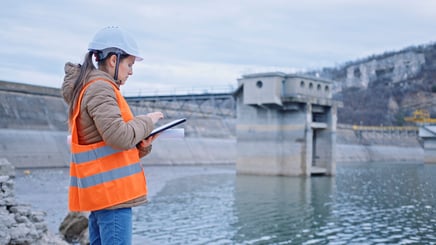Discover river data across the United States with confidence and ease.
A New Way to Discover River Data
Explore who’s monitoring what, where, and how with a new tool powered by the Geoconnex system
A Smarter Starting Point for River Data
There’s a new way to explore who’s monitoring America’s rivers, and how.
The Geoconnex Explorer is the first public application built on the Geoconnex system. With it, you can easily discover data from over a million monitoring sites, filter specific parameters, and link directly back to original data sources — all through a single, map-based interface.
No advanced coding skills required. No guessing where to start. Just clear, connected river data.
 A still of Geoconnex Explorer that shows rivers in the United States Midwest, with the Mississippi River and its corresponding data collection sites highlighted in orange.
A still of Geoconnex Explorer that shows rivers in the United States Midwest, with the Mississippi River and its corresponding data collection sites highlighted in orange.
Where Back-End Innovation Meets Front-End Water Data Discovery
The Explorer marks a major step forward for the Internet of Water. While the Geoconnex system is the behind-the-scenes backbone that connects water data through shared reference points, the Explorer is the first tool to show what that looks like in practice. It’s built on the technical framework of Geoconnex, but designed for anyone to use, regardless of programming experience. Its accessible, non-technical interface offers a window into what modern, open water data infrastructure can make possible. By organizing data spatially by real-world streams and rivers, the tool makes it easier than ever to answer questions like:
- Who’s collecting data on this river?
- What data sources exist around PFAS, pH, chemical concentrations, and flow?
- Are multiple agencies monitoring the same stretch?
You can filter the data by specific variables and time periods, going as far back as a data provider has collected data at a site (in some cases, that’s as early as 1910). In keeping with its Geoconnex design principles, the Explorer maintains directs links to original data sources and offers the ability to download the data and accompanying metadata table into CSV files. Plus, because each river has a specific URL, it’s easy to share a significant amount of data about a specific river.
Try it out for yourself and see what river data you uncover.
What’s Under the Hood
As of July 2025, the Explorer connects to hundreds of thousands of sites from trusted data providers. Contributors include federal agencies, like the United States Geological Survey and the EPA’s Water Quality Portal, state organizations like the Western States Water Council, and research organizations like the Consortium of Universities for the Advancement of Hydrologic Science, Inc. Updates sync approximately every 15 minutes as the data producers update their portals. The data remains hosted by the agencies themselves; Geoconnex simply connects it all into one coherent, accessibly-designed system.
This approach preserves data ownership while improving access. Users get an easy, real-time index to critical water data, and agencies maintain control over their own data, ensuring accuracy, integrity, and trust.
Building Towards the Future
Developing modern data infrastructure is no small feat — especially when it means juggling massive datasets, user-centered design, and the Principles at the heart of the Internet of Water. The Explorer is a major step forward, but it’s just the beginning.
The IoW team at the Center for Geospatial Solutions is eager to incorporate user feedback to improve the Explorer and inform what comes next. From the Geoconnex Governance Working Group helping steer the vision, to the developers constructing and maintaining the system, we’re all asking the same question: How can we help more people find more meaningful ways to explore this data?
Whether it’s developing tools that are intuitive for stakeholders who aren’t experts in water data interpretation or adding discovery tools for other types of water data — the ambition for Geoconnex is as far-reaching as the water community itself.
As use cases pop up from government agencies, tribal nations, researchers, local leaders, and more, we’re excited to keep evolving alongside the needs of the water data community. Let us know what you think. Share your feedback for the Explorer by email, on social media, or through Github.
Try It Out — and Help Shape What’s Next
The Explorer is open to all. We invite you to explore, share, and let us know what's helpful and what could be better.
Want to learn more about how the Explorer works or what’s next? We’ve got you covered! Keep an eye out for an upcoming webinar, watch the demo video, and subscribe to the Connect the Drops newsletter to stay informed about Geoconnex developments and water community events and opportunities.
Keep Exploring
A Breakthrough for Water Rights Data Management in the Western United States
WestDAAT streamlines access to 1.7M+ water rights across the West, empowering smarter water data management, planning, and conservation efforts.
Automating Workflows for All with Open Water Foundation
Learn how open-source tools like TSTool are transforming water data workflows—making it easier to process, visualize, and act on complex datasets.
Putting Tribal & Community Science Data to Work
Leveraging Tribal Government and Community Science Data to Monitor Harmful Algal Blooms By: R. John Dawes
Comments on this post